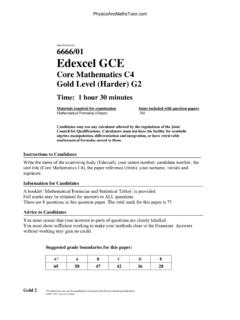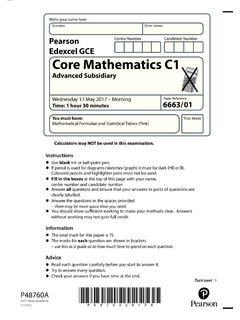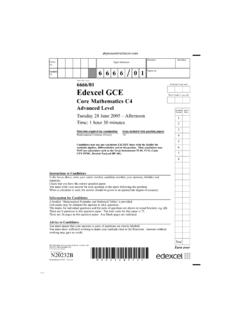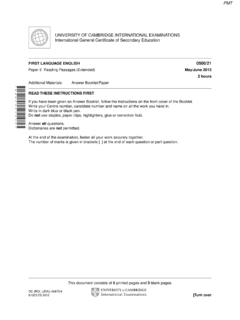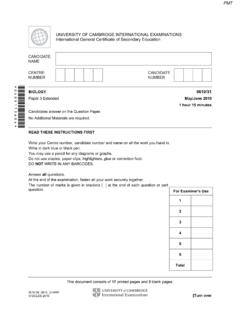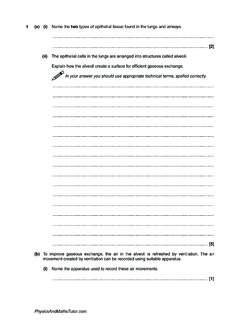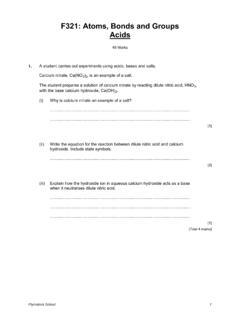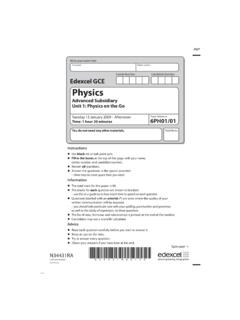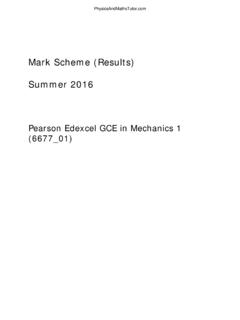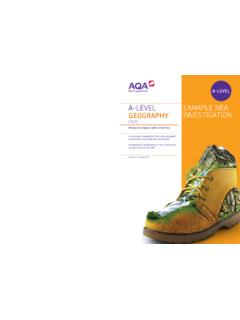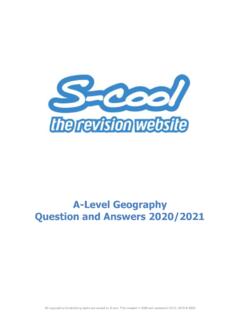Transcription of AQA Geography A-level 3.1.3 - Coastal Systems and …
1 AQA Geography A-level - Coastal Systems and Landscapes Detailed Notes The Coastal system The coast can be considered as an open system as it receives inputs from outside the system and transfers outputs away from the coast and into other Systems . These Systems may be terrestrial, atmospheric or oceanic and can include the rock, water and carbon cycles . Whilst coasts are open Systems , throughout this topic you will be expected to consider the coast as a closed system in some circumstances such as during scientific research and coastline management planning.
2 The Coastal system is impacted and impacts upon processes which occur in the five oceans of our planet and the smaller seas of which they are part of. You should be aware of the different habitats and activities which are affected by and affect the Coastal environment . Some of these are demonstrated in the image below: Source: National Institute of Water and Atmospheric Research New Zealand Sediment Cells Coasts can be split into sections called sediment cells which are often bordered by prominent headlands . Within these sections, the movement of sediment is almost contained and the flows of sediment act in dynamic equilibrium.
3 Dynamic equilibrium refers to the maintenance of a balance in a natural system , despite it being in a constant state of change . The system has a tendency to counteract any changes imposed on the system in order to keep this balance, which is achieved by inputs and outputs constantly changing to maintain the balance. Dynamic equilibrium in a sediment cell is where input and outputs of sediment are in a constant state of change but remain in balance . The dynamic equilibrium may be upset in the long term by human interventions , or in the short term it may be interrupted by natural variations.
4 Within each sediment cell there are smaller subcells . Often the smaller subcells are used when planning Coastal management projects . There are many features to the Coastal system and most are listed below - there is more detail on each throughout these notes. Most of the questions in your exam will focus on how these features and processes affect the Coastal system , though this will not always be explicit in the question title. When you are learning something in this unit, always link it back to the key features below: Inputs: May refer to material or energy inputs.
5 Coastal inputs are not limited to but include three main areas: Marine: Waves, Tides, Salt Spray Atmosphere: Sun, Air Pressure, Wind Speed and Direction Humans: Pollution, Recreation, Settlement, Defences Outputs: May refer to material or energy outputs Ocean currents Rip tides Sediment transfer Evaporation Stores/Sinks: Refer to stores and sinks of sediment and material. The formation of each of these stores is discussed later in these notes Beaches Sand Dunes Spits Bars and Tombolos Headlands and Bays Nearshore Sediment Cliffs Wave-cut Notches Wave-cut Platforms Caves Arches Stacks Stumps Salt Marshes Tidal Flats Offshore Bands and Bars Transfers/Flows.
6 The processes that link the inputs, outputs and stores in the Coastal system Wind-blown sand Mass-movement processes Longshore drift Weathering Erosion Hydraulic Action Corrosion Attrition Abrasion Transportation Bedload In suspension Traction In solution Deposition Gravity Settling Flocculation Energy: The power and driving force behind the transfers and flows in the system Wind Gravitational Flowing Water Feedback Loops The Coastal system has mechanisms which enhance changes within a system , taking it away from dynamic equilibrium ( positive feedback ) or mechanisms which balances changes, taking the system back towards equilibrium ( negative feedback ).
7 Negative feedback loop - this lessens any change which has occured within the system . For example, a storm could erode a large amount of a beach, taking the beach out of dynamic equilibrium as there is a larger input of sediment into the system than output. A negative feedback loop will balance this excess of inputted sediment: 1. When the destructive waves from the storm lose their energy excess sediment is deposited as an offshore bar. 2. The bar dissipates the waves energy which protects the beach from further erosion. 3.
8 Over time the bar gets eroded instead of the beach. 4. Once the bar has gone normal conditions ensue and the system goes back to dynamic equilibrium. Positive feedback loop - this exaggerates the change making the system more unstable and taking it away from dynamic equilibrium: 1. People walking over sand dunes destroys vegetation growing there and causes erosion. 2. As the roots from the vegetation have been holding the sand dunes together, damaging the vegetation makes the sand dunes more susceptible to erosion. This increases the rate of erosion.
9 3. Eventually the sand dunes will be completely eroded leaving more of the beach open to erosion taking the beach further away from its original state. Sediment Sources Rivers: Most of the sediment in the Coastal zone is a result of an input from rivers , especially in high-rainfall environments where significant river erosion occurs. This is demonstrated by the image of the Gulf of Mexico and the sediment flowing from a river delta (Source: NASA). Sediment may be deposited in estuaries which are brackish (salty). areas where rivers flow into the sea.
10 They are important wildlife habitats . The sediment is then transported throughout the Coastal system by waves, tides and currents Cliff Erosion: Very important in areas with unconsolidated (uncompacted and therefore unstable). cliffs that are eroded easily. In some areas, coastlines can retreat by up to 10m per year , providing a significant sediment input . Most erosion occurs during the winter months due to more frequent storms Wind: The wind is a Coastal energy source and can cause sand to be blown along or up a beach Sediment transport by winds may occur where there are sand dunes or in glacial and desert environments which provide sediment inputs Glaciers.
